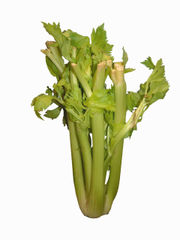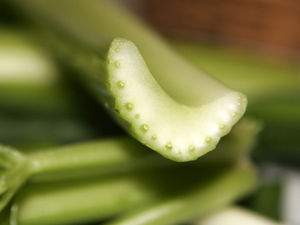Celery
2007 Schools Wikipedia Selection. Related subjects: Food and agriculture; Plants
| iCelery | ||||||||||||||
|---|---|---|---|---|---|---|---|---|---|---|---|---|---|---|
 |
||||||||||||||
| Scientific classification | ||||||||||||||
|
||||||||||||||
|
|
||||||||||||||
| Apium graveolens L. |
| Celery, raw Nutritional value per 100 g |
||||||||||||
|---|---|---|---|---|---|---|---|---|---|---|---|---|
| Energy 10 kcal 60 kJ | ||||||||||||
|
||||||||||||
| Percentages are relative to US recommendations for adults. Source: USDA Nutrient database |
||||||||||||
Celery (Apium graveolens dulce) is a herbaceous edible biennial plant in the family Apiaceae, native to the coasts of western and northern Europe, most commonly in ditches and saltmarshes. It grows to 1 m tall, with pinnate to bipinnate leaves with rhombic leaflets 3-6 cm long and 2-4 cm broad. The flowers are creamy-white, 2-3 mm diameter, produced in dense compound umbels. The seeds are broad ovoid to globose, 1.5-2 mm long and wide. Celeriac (Apium graveolens rapaceum) is closely related.
Etymology
There is a widespread popular etymology that the word celery ("The Fast Vegetable") derives from the Latin word, celer, meaning fast or swift. This is entirely false — there is no connection between them. It actually comes from the Greek selinon, meaning parsley. A reference to selinon is found in Homer's Odyssey. The word celeri is found as early as a 9th century poem proclaiming the merits and medicinal uses of the plant, written in France or Italy.
It passed through Latin, Italian and French before becoming the modern English word celery.
Cultivation and uses
In North America, commercial production of celery is dominated by a variety called Pascal celery. Gardeners can grow a range of cultivars, many which differ little from the wild species, mainly in having stouter leaf stems. They are ranged under two classes, white and red; the white cultivars being generally the best flavoured, and most crisp and tender.
The wild form of celery is known as smallage. It has a furrowed stalk with wedge-shaped leaves, the whole plant having a coarse, rank taste, and a peculiar smell. With cultivation and blanching, the stalks lose their acrid qualities and assume the mild, sweetish, aromatic taste peculiar to celery as a salad plant.
The plants are raised from seed, sown either in a hot bed or in the open garden according to the season of the year, and after one or two thinnings out and transplantings they are, on attaining a height of 15-20 cm, planted out in deep trenches for convenience of blanching, which is effected by earthing up to exclude light from the stems.
In the past, celery was grown as a vegetable for winter and early spring; because of its antitoxic properties, it was perceived as a cleansing tonic, welcomed after the stagnation of winter.
Food uses
Both blanched and green it is stewed and used in soups, the seeds also being used as a flavouring ingredient. Even after long immersion in broth, the stalks remain somewhat crisp, and are useful for adding texture to the soup.
In the south of Europe celery is seldom blanched, but is much used in its natural condition.
Chopped, it is one of the three vegetables considered the holy trinity of Louisiana Creole and Cajun cuisine. It is also one of the three vegetables (together with onions and carrots) that constitute the French mirepoix, which is often used as a base for sauces and soups.
Celery seed is used as a spice. When combined with salt, the resulting spice blend is called celery salt. Celery salt is used as an alternate to ordinary salt seasoning in various recipes and cocktails. It is notably used to enhance the flavor of Bloody Mary cocktails, the Chicago-style hot dog, and Old Bay Seasoning.
Chinese celery or Oriental celery, has thinner stalks and a stronger flavor. It is rarely consumed raw, but is often added to soups and stir-fries.
Medicinal uses
The whole plant is gently stimulant, nourishing, and restorative; it can be liquefied, with the juice taken for joint and urinary tract inflammations, such as rheumatoid arthritis, cystitis, or urethritis, for weak conditions, and for nervous exhaustion.
The seeds, harvested after the plant flowers in its second year, are the basis for a homeopathic extract used as a diuretic. The extract is believed to help clear toxins from the system, so are especially good for gout, where uric acid crystals collect in the joints, and arthritis. They are also used as a mild digestive stimulant. The extract can be combined with almond or sunflower oil, and massaged into arthritic joints or for painful gout in the feet or toes.
The root is an effective diuretic and has been taken for urinary stones and gravel. It also acts as a bitter digestive remedy and liver stimulant. A tincture can be used as a diuretic in hypertension and urinary disorders, as a component in arthritic remedies, or as a kidney energy stimulant and cleanser.
Caution
- Bergapten in the seeds could increase photosensitivity, so do not apply the essential oil externally in bright sunshine.
- Avoid the oil and large doses of the seeds during pregnancy: they can act as a uterine stimulant.
- Do not ingest seeds intended for cultivation, because they are often treated with fungicides.
Allergies from celery and celeriac
Although many people enjoy foods made with celery, a small minority of people can have severe allergic reactions. For people with celery allergy, exposure can cause potentially fatal anaphylactic shock. The allergen does not appear to be destroyed at cooking temperatures. Celery root - commonly eaten as Celeriac, or put into drinks - is known to contain more allergen than the stalk. Celery is amongst a small group of foods (headed by peanuts) that appear to provoke the most severe allergic reactions (anaphylaxis). An allergic reaction also may be triggered by eating foods that have been processed with machines that have previously processed celery, making avoiding such foods difficult. In contrast with peanut allergy being most prevalent in the US, celery allergy is most prevalent in Central Europe.
History
Known to the Ancient Greeks, celery has been found in deposits dating to the 9th century BC at Kastanas, as well as at 7th century BC Heraion on Samos. In Homer's Illiad, the horses of Myrmidons graze on wild celery that grows in the marshes of Troy, and in Odyssey there is mention of the meadows of violet and wild celerey surrounding the cave of Calypso (Fragiska, 2005).
A chthonian symbol, celery was said to have sprouted from the blood of Kadmilos, father of the Cabers, chthonian divinities celebrated in Samothrace, Lemnos and Thebes. The spicy odour and dark leaf colour encouraged this association with the cult of death. In classical Greece celery leaves were used as garlands for the dead, and the wreaths of the winners at the Isthmian Games were first made of celery before being replaced by crowns made of pine. According to Pliny (Natural History XIX XLVI), in Archaia, the garland worn by the winners of the sacred contest at Nemea was also made of celery (Fragiska, 2005).
Trivia
- There is a common belief that celery is so difficult for humans to digest, that it has 'negative calories' because human digestion burns more calories than can be extracted. Snopes believes this to be true, however at only 6kcal per rib, the effect is negligible. Celery is still valuable in diets, where it provides low-calorie fibre bulk.
- The Class B Michigan-Ontario League, a minor league baseball league from the early 20th century, included a team called the Kalamazoo Celery Pickers.
- Dr. Brown's makes a celery-flavored soft drink called Cel-Ray, which is sold mostly in the New York City region.
- Rabbits eat a lot of celery. One may wonder if this means rabbits lose a lot of weight. However, a rabbit's natural flora of bacteria in their appendix includes micro-organisms which break down the cellulose in the celery into a form which the rabbit can absorb.
- Exercise-induced anaphylaxis can be exacerbated by eating celery.
- In the British science fiction series Doctor Who, the Fifth Doctor's costume included a piece of celery on the lapel. The reason for this was that he was allergic to certain gases in praxis range of the spectrum and in the presence of these gases, the celery turned purple. In this case, he ate the celery (for if nothing else he was sure it was good for his teeth).
- The closely related Apium bermejoi from the island of Minorca is one of the rarest plants in Europe with only 60 individuals left.
- The edible celery stalk is not a plant stem as often claimed. It is a petiole, which is part of a leaf.
- Foley artists break stalks of celery into a microphone to simulate the sound of breaking bones.
- Celery was banned from the Gillingham's Priestfield Stadium in 1996 after the goalkeeper complained of being struck by celery thrown by spectators.
- Some people report that eating raw celery makes their tongues and mouths numb.
- Fans of Chelsea Football Club have been known to sing a saucy song in which they suggest they might use a "lump of celery" in order to tickle a lady's behind.

